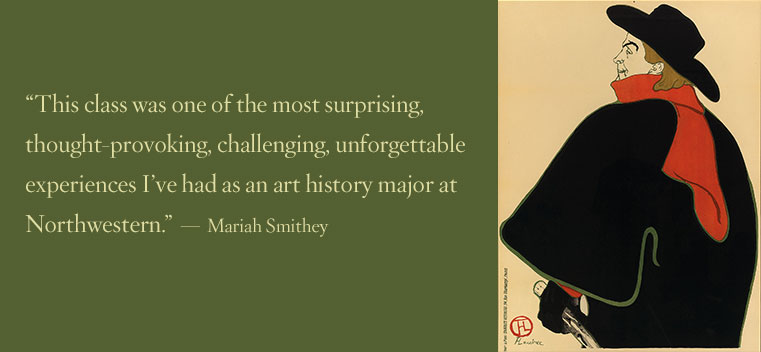
Collections: Toulouse-Lautrec’s Paris Prints
Tell us what you think. E-mail comments or questions to the editors at letters@northwestern.edu.
Ever wonder about those strange designations we use throughout Northwestern to identify alumni of the various schools of the University? See the complete list.
Find Us on Social Media
Student-curated exhibit highlights postermania in Paris.
In the final decades of the 19th century, brightly colored posters transformed the city streets of Paris. Large-scale lithographs advertising commercial entertainments, both respectable and risqué, altered the urban environment. The movement, fittingly called affichomanie, or postermania, set the stage for the French artist Henri de Toulouse-Lautrec’s rise to fame.
Even prior to his signature public posters, Toulouse-Lautrec had begun to specialize in the representation of marginal pleasures of Paris by the beginning of affichomanie. He immersed himself in the city’s new entertainment culture and was even known to live in various brothels for weeks at a time so that his art could sympathetically record the lives of the women who made him their confidant. His first lithographic poster was an 1891 advertisement for Le Moulin Rouge, the first Parisian club to explicitly feature tawdry performances with a bourgeois audience in mind.
A Mary and Leigh Block Museum of Art spring exhibit, Toulouse-Lautrec Prints: Art at the Edges of Modernity, explored the scope of Toulouse-Lautrec’s prints. Thirteen Northwestern undergraduate students curated the exhibit, led by art history professor S. Hollis Clayson in an ongoing series of undergraduate class–curated exhibitions at Northwestern. Clayson’s class included a trip to the Museum of Modern Art in New York City to explore its exhibition of Toulouse-Lautrec’s works.
“This class was one of the most surprising, thought-provoking, challenging, unforgettable experiences I’ve had as an art history major at Northwestern,” says senior Mariah Smithey. “Working with museum professionals and collectors, taking a trip to MoMA with your professor, getting to work with the most beautiful Toulouse-Lautrec prints — who gets to do that as an undergraduate?”
Chosen from Toulouse-Lautrec’s broad range of lithographic work, the 18 selected pieces in the Northwestern exhibit were lent from the private collection of Andra and Irwin Press ’59, who have bequeathed a significant number of works from their collection to the Block Museum.
The exhibit was also part of a Block Museum initiative to provide gallery space and museum resources to student-curated exhibitions. “It was a challenging sort of experiment,” says Clayson, a 19th-century French art expert who had never curated an exhibit with undergraduates. “We were really determined to show the diversity of his art and of the communities he represented as well as the range of functions his work served.”



 Facebook
Facebook Twitter
Twitter Email
Email


